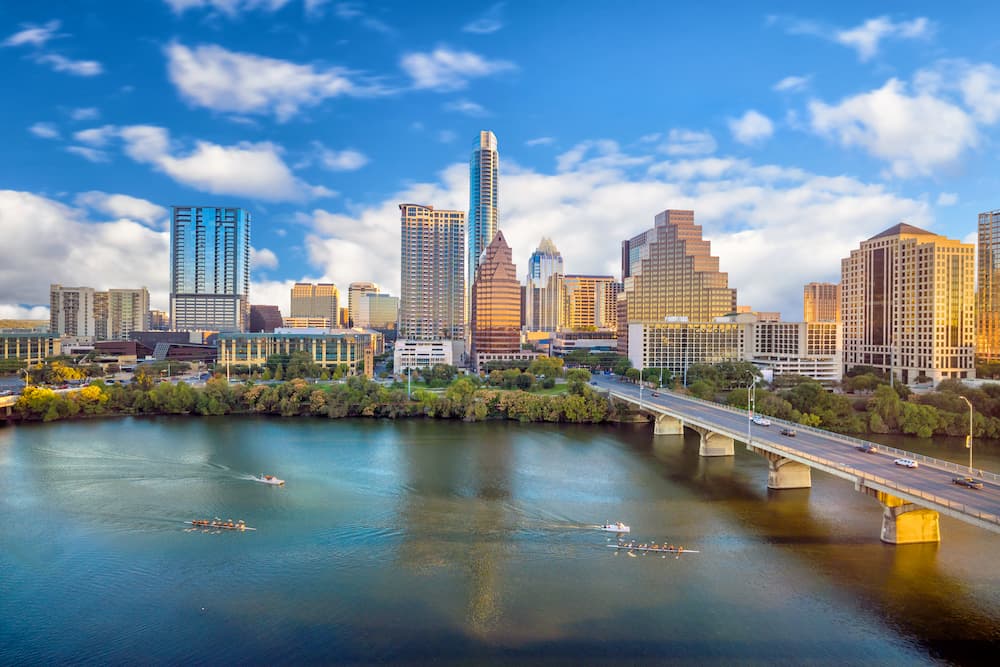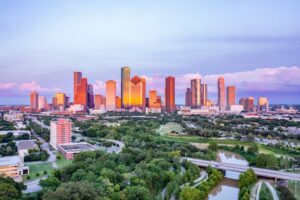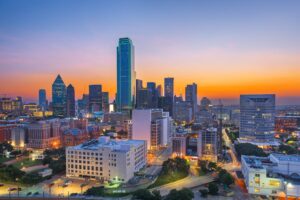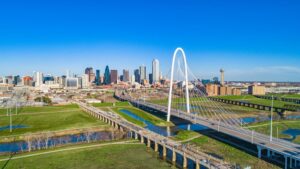
With its reputation as a hip, eclectic, and beautiful place to live, it’s no wonder that Austin has seen an influx of new residents in the past few years. Known for its fabulous food, music, and outdoor adventures, the city of Austin has all the amenities you’d expect from a major metropolis, but it’s managed to preserve a certain level of affordability – and an undeniably unique character – nevertheless. Keep reading to learn about the overall average cost of living in Austin, TX in 2023-2024.
The overall cost of living in Texas was below the national average for quite some time, though it’s recently caught up and slightly surpassed that number. Even so, many Austinites argue that the quality of life in Austin is well worth the monthly costs. If you compare Austin’s cost of living to other similarly-sized cities in Texas, it’s on par with that in Dallas and Houston. And when measured against the cost to live in other booming, tech-driven cities such as San Francisco and Seattle, Austin is downright an affordable city.
Between 2010 and 2020, the city grew by nearly 35%, driving some serious competition in the housing market that continues today – and as a result, the cost of living in Austin may begin to rise. So, if you’re considering becoming an Austinite yourself, there’s never been a better time to make your move. And to help you decide if you’re ready to relocate to the area, we’ve put together a useful guide that breaks down the various costs associated with living in Austin, so pull on your cowboy boots and get ready to dig into the details.
Housing costs in Austin
Anytime you move to a new city, your perspective on the affordability of housing will largely depend on where you’re coming from. For example, people coming from high-priced locales like New York City life are likely to find Austin homes for rent and housing costs refreshingly affordable. But if you’re moving to Austin from a small, rural community, you might discover that it’s more expensive than you expect.
In fact, the average rent in Austin has dropped about 13.5% in the past year or so. If you were to figure out Austin’s average monthly rate across its various neighborhoods, the figure would be somewhere around $1,300 per month for a one-bedroom apartment.
Granted, the average price of your monthly rent in Austin can vary dramatically depending on what part of town you’re living in. As you’d probably predict, the trendier parts of town tend to have a higher rental price, but there are also great neighborhood options for the budget-conscious price range.
- Centrally-located neighborhoods, including Downtown Austin, Bouldin Creek, the Warehouse District, and the Seaholm District, are among the most expensive parts of the city, averaging between $2,280 to $2,850 for a one-bedroom apartment.
- In the family-friendly communities of North Loop, Brentwood, and Clarksville, the average rent falls somewhere in the middle, ranging from $1,125 to $1,380.
- If affordability is your top priority, check out neighborhoods like North Lamar or Gracywoods, where apartments average about $850-900 per month.
For homebuyers, Austin home prices are generally competitive with comparative areas. However, it’s a sellers’ market, and many homes sell quickly at figures well-above the asking price. The average sale price of a home in Austin is about $450,000, though that number has been steadily increasing. According to the Census, the median selected monthly owner costs in Austin (with a mortgage) are about $2,031, making renting a far more affordable option for many residents.
Food costs in Austin
Austin is a foodie’s paradise, serving up everything from authentic Texas barbeque to global cuisine. There’s something new to sample around every corner, and the cost of grocery prices in Austin is about 8% lower than the national average – so you might be able to afford dining out more than you’d think!
Some examples of Austin’s average grocery costs include:
- A dozen Grade A eggs: $1.39
- A half-gallon of milk: $1.84
- A head of iceberg lettuce: $1.35
With so many great restaurants in Austin, you can easily eat out on a budget; or, you can treat yourself to fine dining. In general, you’ll find yourself spending less than you would in many other major cities. On average, the cost of a three-course restaurant meal in Austin is about $50 per person, but you can certainly spend a lot more or less than that. Whether you want to grab $1 tacos from your neighborhood taco truck or indulge in a pricey meal at a superior-quality steakhouse, you can always find something tasty to try.
Austin utility costs
Austinites aren’t afraid to humble-brag about the area’s fantastic weather, especially the mild winters. But during the summer, it can get pretty hot and humid, so your air conditioning will definitely be put to work. Luckily, the cost of utilities (including water, electricity, trash pickup, and gas) in Austin averages about $150 per month, which is 5% less than the national average.
Transportation costs in Austin
Traffic is a hot topic in Austin, with the city earning the less-than-honorable ranking of one of America’s top 10 worst commutes (totaling about 40 minutes). The good news is that Austin transportation costs are about 10% lower than the U.S. average, so it does even out somewhat. And if you live Downtown, walking, biking, or using public transit or rideshare services can get you reasonably far within the heart of the city. Beyond the Downtown area, you’ll probably want to plan to drive.
Most Austinites use their cars for getting around the majority of the time, and gas prices can fluctuate on an ongoing basis, much like other U.S. cities. But typically, Austin gas prices are about 40 cents less than the national average – so, fill ‘er up! Some toll roads in and around Austin can add up if you’re commuting from outside the city. Depending on your route, investing in a TxTag might be a money-saving choice.
Prefer public transit? Capital Metro is a public transportation provider that facilitates various buses and commuter train routes, offering seven-day passes for $11.25-27.50 (bus vs. rail fares). Compared to the average cost of an Uber or Lyft in Austin (specifically one taking you from the city center to a neighborhood on the outskirts of town), which runs around $30, public transit is pretty budget-friendly.
Healthcare costs in Austin
Austin’s healthcare cost will inevitably differ from person to person, simply because we each have our own specific needs and wellness goals. A routine checkup with a general practitioner will cost about $118 in Austin, whereas a dental cleaning and exam total around $121. Without insurance coverage, your prescription costs are in line with the national average; over-the-counter medications are generally pretty inexpensive.
Goods and services costs in Austin
Once you have the bare necessities covered, you can start thinking about the “non-essential” elements that contribute to your overall quality of life in Austin. With so much to do, see, and experience in Austin, it’s great to know that the area is right on target with the national average for the cost of consumer goods and services.
For example:
- The average cost of a movie theater ticket in Austin is $10.53
- The average cost for a yoga class in Austin is about $20, with tons of options for affordably monthly memberships
- Visiting the beauty salon will run you around $50, while a basic haircut is about $28
Are you considering the cost of living in Austin while sticking to a tight budget? Don’t worry because Austin offers an array of free amenities, including numerous parks, walking trails, hikes, live music, and more.
Taxes in Austin
Come tax time; you’re bound to appreciate living in Texas because there’s no state income tax.
Texas state sales tax is 6.25%, with a total 8.25% sales tax in Austin. However, there are three major sales tax holidays in Texas, giving you the opportunity to rack up some big savings if you shop smart. Each tax holiday targets a specific category, giving shoppers a break from sales tax on qualifying items: April is emergency preparation supplies, Memorial Day weekend is energy-efficient and water-saving products, and August is for back-to-school supplies.
How much do you need to earn to live in Austin?
As a rule of thumb, your rent should be at or below 30% of your total income. So, if you’re renting an Austin apartment at the city’s average of $1,318 per month, you’ll need to make a minimum of $52,570 per year.
The United States Census Bureau reports that the median household income in Austin is about $71,500, with the per capita income averaging around $43,000.
Ready to Find Your Next Home in Austin, TX?
If you ask most locals, life in the ATX – one of many nicknames for Austin – lives up to all the hype. The city has all the personality, charm, and quirkiness of a small town, alongside the flourishing economy, job opportunities, and first-class dining and entertainment of a major metropolis. The city’s unofficial motto is “keep Austin weird,” which tells you everything you need to know about its dedication to authenticity and fun.
In one of Wan Bridge’s many build-to-rent communities, you can find homes for rent near Austin that offer the best of both worlds: a close proximity to one of the most desirable locales in the country, along with the ample space and thoughtful amenities of a suburban, master-planned community. As one of our newest build-to-rent neighborhoods, Georgetown Heights homes are inspired by a combination of contemporary design and Southern charm. You’ll enjoy the benefits of spacious, open-concept floor plans, upgraded finishes, two-car garages, and private outdoor spaces, all within easy driving distance of Austin’s city center. And with more than a dozen unique floor plans to choose from, there’s a home to suit even the most specific of needs.
Explore your options for homes for rent in Austin and see why the area has become a hot spot for new residents. Contact Wan Bridge to learn more about our innovative communities today!
Related Resources
- 6 Best Suburbs of Austin, TX
- Moving to Austin: Everything You Need To Know
- Moving to Texas: Everything You Need To Know
- Moving from California to Texas in 2024
- Best Places to Live in Texas
Image Source: f11photo / Shutterstock






